Conference Report (The University of Leeds, UK, 12–14 September 2016)
By Roger Norum
A version of this report was first published 17 October 2016 on ENHANCE ITN.
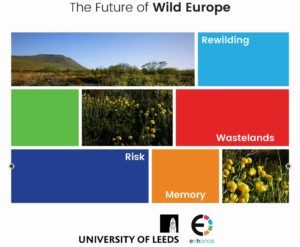
This three-day conference was the first of three large events for the ENHANCE ITN (The Environmental Humanities for a Concerned Europe Innovative Training Network), a three-year Marie Skłodowska-Curie doctoral research program convened by the University of Leeds, the Rachel Carson Center at LMU Munich, and KTH Royal Institute of Technology. Because ENHANCE is an inherently interdisciplinary project, we decided to organize the conference around a theme that would not just appeal to both social scientists and humanities scholars, but that would also showcase current research by young and emerging scholars across disparate fields, while also questioning the configurations of the very categories and concepts we use to talk about the environment in the context of a changing Europe—and beyond.
Our hope in putting on this conference was that by inviting participants from vastly different perspectives and disciplinary backgrounds, we might inspire scholars new to the environmental humanities (EH) to want to see their world through the lenses of others. EH, after all, champions new and intertwined narratives and multiple visions for the construction of environmental meaning. In focusing on Europe, we wanted to see whether differing national and international perspectives on the environment and its changing realities and representations might be brought together to speak to one another. As it happened, about midway into our preparations for the conference, the Brexit referendum vote took place, which, among other things, called into question national, EU, pan-European, and indeed global considerations of environmental conservation, international jurisdiction, and political sovereignty. However, while “Brexit” was mentioned on a handful of occasions during The Future of Wild Europe, more important is that the conference as a whole served as a reminder of how important it is that we keep our visions of and perspectives on Europe, what it is and what it might become, as broad and as open as possible.
Over the three days, a total of 87 scholars were in attendance at the conference, held in the University’s nineteenth-century Clothworkers Centenary Concert Hall. A diverse constellation of sessions presented the research of several dozen doctoral students, early career researchers, and senior scholars working on various topics pertaining to the environment in Europe, and beyond. Below are some of the conference highlights:
MONDAY, 12 SEPTEMBER
Jamie Lorimer from the University of Oxford opened the conference with a brilliant keynote talk that was specific in content and context, but global in scope. Considering regimes of knowledge which often monopolize discourse and practice, Jamie explained how the genetic heritage of a certain herd of cattle in 1930s Germany was mined in order to breed German domestic cattle in the exact image of their extinct antecedents, embodying ideals of genetic science and notions of racial purity in Nazi Europe. These very same cattle have been implicated in various plans for rewilding occupied territories of the former Soviet Bloc, with the aim of restoring “naturalistic” grazing regimes akin to those that were in place at the end of the last ice age. Jamie’s was a poignant talk about nation, history, and environment that was an encouraging and thought-provoking beginning to the next three days.
The keynote was followed by two concurrent panel presentation sessions by doctoral students and postdoctoral scholars: Visions (Alejandro Reig, Anna Antonova, and Valentina Gamberi/Lucia Zaietta) and Perspectives on Rewilding (Miranda Strubel, Alexandra Hampson, and Ian Philips). Wild / Walled, a late morning creative session organized by ENHANCE and KTH doctoral students Irma Allen and Anne Gough, then led participants through the bridges, fences, walls, barriers, and thresholds of the Leeds University campus. Irma and Anne posed provocative questions for participants to consider as they ventured out to explore in tactile ways how our built environments are, to varying degrees, built as walled or wild spaces. Intended to spark imaginations and generate ideas, these group explorations encouraged participants to experience the tensions of enclosed spaces and excluded bodies, of the fenced in (spaces, environments, landscapes), and the fenced out (people, cultures, nonhumans).
That afternoon, Oxford-based writer and legal ethicist Charles Foster spoke about his recent book Being a Beast, in which he burrowed himself into the experience of “being” various animals. Charles’s book is extremely experiential and his research methods often extreme; his talk was a beautiful, discursive walk through his animalistic travels—venturing underground as a badger, dustbin and dumpster diving in London as a fox, and swimming in Exmoor’s rivers with otter. Charles poetically presented some of his musings on what his em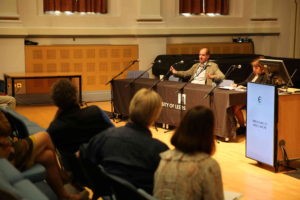 pirical research taught him, explaining that when humans became physically less grounded (e.g. learning to stand up some 6 million years ago), we lost important sensory and cognitive connections to the Earth. Much of human experience, he further surmised, is tyrannized by our leading sense: vision. Charles’s research and writing was aimed in part at defamiliarizing himself from sight and (re)learning the use of his other senses: olfactory, tactile, aural. The session was moderated by literary geographer Amy Cutler (Royal Holloway), who until recently held the position of Postdoctoral Fellow in the Environmental Humanities at Leeds.
pirical research taught him, explaining that when humans became physically less grounded (e.g. learning to stand up some 6 million years ago), we lost important sensory and cognitive connections to the Earth. Much of human experience, he further surmised, is tyrannized by our leading sense: vision. Charles’s research and writing was aimed in part at defamiliarizing himself from sight and (re)learning the use of his other senses: olfactory, tactile, aural. The session was moderated by literary geographer Amy Cutler (Royal Holloway), who until recently held the position of Postdoctoral Fellow in the Environmental Humanities at Leeds.
Marco Armiero (KTH) then led a roundtable that explored the various challenges of environmental justice in Europe. Invited scholars Stefania Barca (Coimbra), Richard Kerridge (Bath Spa), and Kate Rigby (Bath Spa) engaged in something of an archaeological excavation of the concept of environmental justice. Among other things, Kate Rigby panned through different aspects of the ways in which environmental care and damage emerge in Australia. Impacts of environmental destruction do not always follow class lines or just punish the poor, she argued, and for aboriginal people, “wild country” is not virgin land, but rather a country that no one has taken care of.
For the final session of the day, Sabine Höhler (KTH) convened an engaging evening discussion about contemporary careers in and out of EH. She brought together Toby Aykroyd (Wild Europe), Katie Ritson (RCC), Sverker Sörlin (KTH). and Helmuth Trischler (RCC), who shared with the audience how they got to where they are today. All four panelists offered up anecdotes and advice, sparked in part by a discussion on the precariousness of contemporary academic careers, on how budding early career researchers might arm themselves with the complementary and intersectoral skills that will offer them multiple career options. These days, being an early career researcher also means becoming a public intellectual—someone who can speak fluently both within and beyond academia. To be sure, there are compelling employment opportunities well beyond the ivory tower, including environmental consultancy, research and development, museum and heritage management, green business and sustainable technology development, media and communications, and not-for-profit work. Successful team collaboration is swiftly becoming a prerequisite for a successful future career, and the conference itself was a testament to the collective spirit of EH research, both inside and outside the academy.
TUESDAY, 13 SEPTEMBER
Dolly Jørgensen from the University of Luleå opened the second day with a keynote entitled “Conflict in a Wilder World: Of Muskoxen and Men in Scandinavia.” The lecture built on Dolly’s recent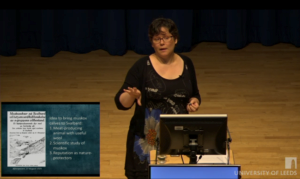 compelling work on the reintroduction of muskoxen to Scandinavia, considering the human inhabitants of the areas where muskoxen were released—and how their opinions were treated by regional and national authorities. Muskoxen became an ornament, an icon, and a tourism marketing tool in a number of areas in Scandinavia. Dolly showed how, ultimately, the view held by local Sami in Sweden about what should be done with muskoxen did not gel with what communities of conservationists and scientists were hoping to hear. Her talk demonstrated that, even when local input on environmental policy is solicited and considered, it is often subsequently discarded when policy decisions are actually being made by those in centers of power.
compelling work on the reintroduction of muskoxen to Scandinavia, considering the human inhabitants of the areas where muskoxen were released—and how their opinions were treated by regional and national authorities. Muskoxen became an ornament, an icon, and a tourism marketing tool in a number of areas in Scandinavia. Dolly showed how, ultimately, the view held by local Sami in Sweden about what should be done with muskoxen did not gel with what communities of conservationists and scientists were hoping to hear. Her talk demonstrated that, even when local input on environmental policy is solicited and considered, it is often subsequently discarded when policy decisions are actually being made by those in centers of power.
A subsequent roundtable panel led by the University of Leeds’ Steve Carver brought together a group of practitioners and scholars to speak about what ideas and practices of rewilding mean today to various actors in Europe. The international discussants included Toby Aykroyd (Wild Europe), Franz Krause (University of Cologne), Thierry Lefebvre (IUCN French Committee), and Nadya Vangelova (Fund for Wild Flora and Fauna). The panel addressed some of the incentives and barriers to rewilding in the face of current European conservation practice and discussed solutions and compromises across different conservationist ideologies. Franz Krause memorably reminded us, when he spoke about the desire of many people and institutions to capture and manicure wild spaces and beings, that “it’s always difficult to park wild things in a park.” The paper presentation panels that followed included Designing the Urban Wild (Cathel Hutchinson, Daniele Valisena, and Barbora Bakošová/Radoslava Krylová) and Wild Policy (Jonathan Carruthers-Jones, Brenda Maria Zoderer, and Zoltán Kun).
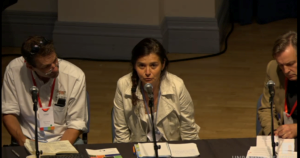
In the subsequent Perspectives on Rewilding presentation panel, Clare Bissell spoke about the social and political narratives framing a rewilding project in a semi-subsistence farming village in Romania. She explained that rewilding may have greater potential for local participation than other forms of conservation, but that as a practice it needs the input, effort, and engagement of a community’s workers for it to be truly effective. Magnus Jacobsen spoke about the politicization of carnivore conservation in Norway, generating conflict between various social, economic, and conservationist interests and ultimately changing the way viability became defined through political processes. His paper showed how the very conceptual frameworks used in the discourse concretely transformed physical reality—and the discourse itself. And Cristian Altaba, an academic who is also director of the Llevant Natural Park in Mallorca, spoke to new opportunities for rewilding the biodiverse, protected areas of his parklands. In fact, his talk generated so much interest that several ENHANCE team researchers are already planning a collaborative workshop in Spain to help brainstorm how this might be seen through to fruition.
A concurrent panel session on the topic of Risk (Arvid van Dam, Caitlin Stobie, and Jeroen Oomen) was an exemplar of how the conference managed to bring together scholars working on vastly different topics, but which nevertheless found synergy once they were reflected against one another. For example, Jeroen Oomen from the RCC gave a presentation from his doctoral work on the societal role of science and technology in climate engineering. He reflected on society’s dream of controlling the wild, and asked whether climate engineering might one day end wildness altogether. In the same panel, Arvid van Dam from the University of Leeds spoke about the ways in which the narratives of the desert told by Spaghetti Western films (e.g. Sergio Leone’s “Dollars Trilogy”) reflect and influence European ideas of aridity, desert landscapes and—quite possibly—environmental policy. Caitlin Stobie, also from Leeds, then discussed feminized nature and problematized motherhood in Jean Rhys’s work Voyage in the Dark. The book’s writing, she argued, promotes patriarchal indifference as a moral response to women’s decisions—and to their futures.
Once the speakers had finished, discussant Anne Gough effortlessly tied the seemingly disparate talks together. She noted that the papers all linked creatively into the multiple scales of risk—from the nature of bodies and gender to global climate ecologies. It was particularly interesting that each of the paper presentations included such a strong visual argument, either employing historical images in support of their point or critiquing the images most commonly broadcast in the representation of place. The session was a great example of successful interdisciplinary scholarly engagement. Each of these three young scholars, hailing from unrelated backgrounds (philosophy, anthropology, and literary studies) and focusing on diverging topics in different disciplines, was able to speak to one another’s work fluently.
That same day, b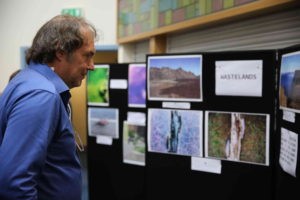 uilding on discussions about visuality, ENHANCE and RCC doctoral students Claire Lagier and Vikas Lakhani put on Postcards from the Edge of Wilderness, a creative session on visual ethnography. The workshop encouraged participants to engage with several dozen photographs from the ENHANCE doctoral students’ research fieldwork, discursively critiquing the photographs and their own reactions to them. The aim was to get participants to reflect upon whether photography could positively contribute to (or detract from) research practices in EH. If photographs can hide power relations, propagate romantic notions of virgin nature, and make actors (not least of all photographers themselves) invisible, what role might environmentally-themed photographs play in an era where photographs are increasingly used for commercial purposes to capitalize on ideas of rapid environmental change? The photo viewing was followed by a question and answer and discussion session about participants’ thoughts and reflections on the photographs.
uilding on discussions about visuality, ENHANCE and RCC doctoral students Claire Lagier and Vikas Lakhani put on Postcards from the Edge of Wilderness, a creative session on visual ethnography. The workshop encouraged participants to engage with several dozen photographs from the ENHANCE doctoral students’ research fieldwork, discursively critiquing the photographs and their own reactions to them. The aim was to get participants to reflect upon whether photography could positively contribute to (or detract from) research practices in EH. If photographs can hide power relations, propagate romantic notions of virgin nature, and make actors (not least of all photographers themselves) invisible, what role might environmentally-themed photographs play in an era where photographs are increasingly used for commercial purposes to capitalize on ideas of rapid environmental change? The photo viewing was followed by a question and answer and discussion session about participants’ thoughts and reflections on the photographs.
Despite a packed schedule , participants still managed to find moments in between panels and during the many coffee breaks to catch some downtime and share ideas with new-found colleagues. The leafy Leeds campus provided some great spaces to stretch out and kick back, and thankfully the Yorkshire weather gods looked down kindly upon us for the duration of the conference.
WEDNESDAY, 14 SEPTEMBER
Elizabeth DeLoughrey (UCLA) opened the conference’s final day with a thought-provoking keynote, “Dewilding the Atlantic: Submarine Futures of the Anthropocene Ocean,” which spoke to the role of the ocean as fundamental to our new understandings of the Anthropocene. Liz’s brilliant work has done much to link EH and postcolonial studies through her postcolonial ecocriticism, which connects discourses and practices of empire and environment. The keynote spoke to new scholarship in critical geography (by, e.g. Phil Steinberg) that is thinking through the ocean as a superorganism and multispecies space, as opposed to merely a background for the explorations, excesses, and excrement of human history. In her talk, Liz argued that we are experiencing shifts in the oceanic imaginary due to sea level rise—the clearest evidence we have of climate change—which are challenging Western bifurcations of culture and nature, city and wilderness, and bringing about new human and nonhuman entanglements. She presented the fascinating example of Jason deCaires Taylor’s dynamic underwater sculptures, devastatingly beautiful artworks that are necessarily subject to erosion and oceanic currents, and as such re-form as reefs over time. Liz’s presented Jason’s works as themselves sea ontologies—entities that are “rendering uninhabitable space into anthropomorphized place.”
The keynote was followed by the final series of concurrent sessions: Wildlands <> Wastelands (Rémi Beau, Jesse Peterson, Kerry Morrison, Joanne Hudson/Becky Sobell); Wild Policy (Agata Agnieszka Konczal, Mackenzie Cramblit, Louise Senior, María Carolina Rodríguez Acero); Memory (Andrew Gordon Jeffrey, Jason Harrison, Lucy Rowland); and Visions (Eveline de Smalen, Veronica Fibisan, Sarah Elizabeth Yoho). A subsequent workshop on filmic narrative was convened by Marcus Hall (Zurich), who screened a collection of excerpts from various rewilding-related films, then challenged participants to brainstorm collaboratively to produce a concrete idea for a film on environmental themes.
In the afternoon, Liz DeLoughrey and Graham Huggan led an intimate session dedicated to Leeds University colleague Anthony Carrigan, who tragically passed away earlier this year. Anthony was a perfect example of a successful early career researcher; even in his mid-30s, he had already left his indelible mark on the academic world, both in his intellectual and political engagement, and in his interest in encouraging the work of other young scholars. Anthony was one of the coauthors of the ENHANCE ITN grant proposal and had become a champion of EH in Europe and beyond. The group discussed some of Anthony’s writings, celebrating his many contributions to the fields of postcolonial disaster studies and the environmental humanities.
The conference concluded with a double-header evening of closing keynote lectures that filled the 250-seat concert hall. Leeds University Vice-Chancellor Sir Alan Langlands and the University of Iceland’s Professor Katrín Lund introduced our first esteemed guest, Guðni Th. Jóhannesson, the newly elected President of Iceland. As a political historian who is now himself making history in politics, Guðni’s presence at the conference was a testament to the importance of academics speaking to different audiences and engaging in a variety of discourses.
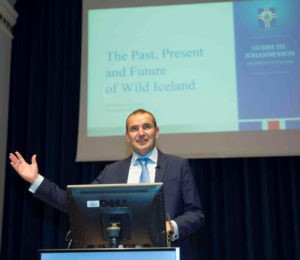
In his keynote lecture, Guðni spoke about the past, present, and future of the natural environment in his country. His talk presented an overview of the contested relationship between humans and nature in Iceland up to the contemporary age, a time when the tourism industry has transformed the country and may well be changing how many Icelanders situate themselves in relation to their land/scape. Guðni discussed recent suggested plans to turn the interior of Iceland into a playground for tourists—tourism in the interior of the country has increased twenty percent each year for the past five years, and the number of tourist arrivals in the Iceland in 2015 exceeded a whopping one million people. He suggested that in Iceland nature has been master in the past (something that could in fact be said about much of the planet); humankind is master in the present; and in the future, it will be humans and nature together. If the future is to be a sustainable one for the planet and for humankind, Guðni argued, humans will need to “seek a balance between humans and nature.”
Given everything that had been going on politically in the UK (and US) in the months prior, it was refreshing for many in the audience to hear a head of state speak so clearly, intelligently, and in such a levelheaded manner—unscripted—about the risks of current and future environmental change.
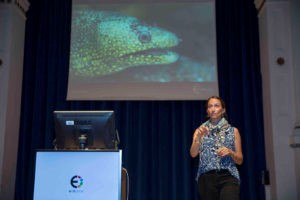 Celine Cousteau, granddaughter of conservationist-explorer Jacques-Yves and daughter of Jean-Michel, then gave the conference’s final keynote talk. Presenting a panorama of committed engagement to educating the public on the environment, Celine spoke about the legacy of the Cousteaus and the work she and her family are passionately involved in to encourage preservation of the world’s oceans. She showed how a sustained hands-on, full-body immersion into liquid environments that sustain life on the planet can itself become a powerful initiative of environmental activism, challenging the powers that be to do their part in defending our common oceans. The conference was officially closed by a wine and canapés evening cosponsored by the Priestly International Centre for Climate, a new institute at Leeds that is further strengthening the University’s commitment to research and dissemination of environmental issues.
Celine Cousteau, granddaughter of conservationist-explorer Jacques-Yves and daughter of Jean-Michel, then gave the conference’s final keynote talk. Presenting a panorama of committed engagement to educating the public on the environment, Celine spoke about the legacy of the Cousteaus and the work she and her family are passionately involved in to encourage preservation of the world’s oceans. She showed how a sustained hands-on, full-body immersion into liquid environments that sustain life on the planet can itself become a powerful initiative of environmental activism, challenging the powers that be to do their part in defending our common oceans. The conference was officially closed by a wine and canapés evening cosponsored by the Priestly International Centre for Climate, a new institute at Leeds that is further strengthening the University’s commitment to research and dissemination of environmental issues.
All told, the conference was a real labor of love, and the conference-related events stretched over nearly a week, bookended by a field trip to the Yorkshire Dales and a series of training sessions, policy workshops, and disciplinary masterclasses for the doctoral students, as well as a number of student and staff meetings. Our hope was that The Future of Wild Europe would help emerging scholars working on the environment to develop the confidence to criticize the limitations of traditionally defined disciplinary backgrounds. It is common these days to talk the talk of interdisciplinarity; surprisingly few individuals and institutions, though, seem to be actually interested in (or successful at) walking the walk. For those of us working on the ENHANCE project, this conference was the first step in encouraging scholars of the environment to do just that.
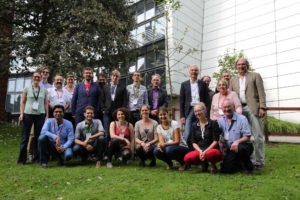
There is a bright future of collaboration out there for researchers who are open to constructive critique from colleagues with differing perspectives. If environmental challenges are one of the primary concerns we face today, then such collaborative, engaged conferences can serve as timely reminders of the importance of questioning the ways in which we think about and understand the environment and its many changes, and of talking with each other about what we want do to about them.
We at Leeds would like to thank the entire ENHANCE ITN and staff at the University of Leeds School of English for organizing and funding the workshop, all the ENHANCE doctoral students and staff for their help in and participation at the conference, and all the conference participants for their remarkable contributions. The next major event organized by the ENHANCE ITN team will be a late-summer school in Stockholm next autumn. Watch this space.
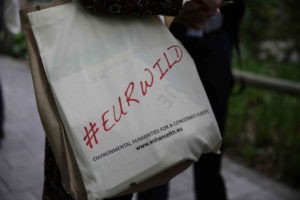









Leave a Reply